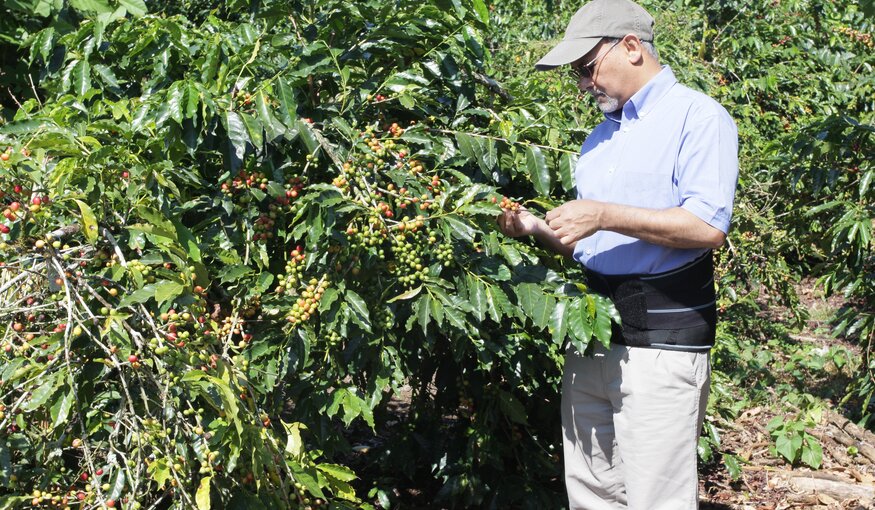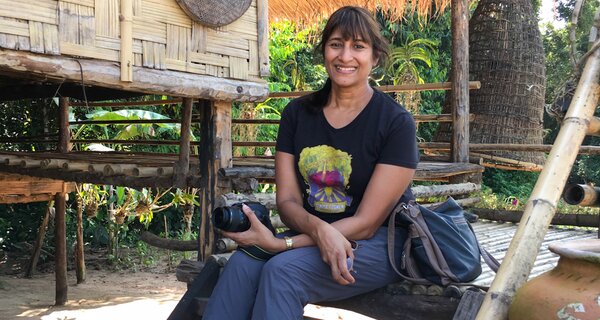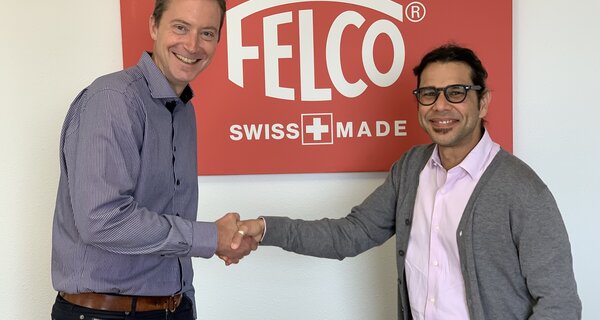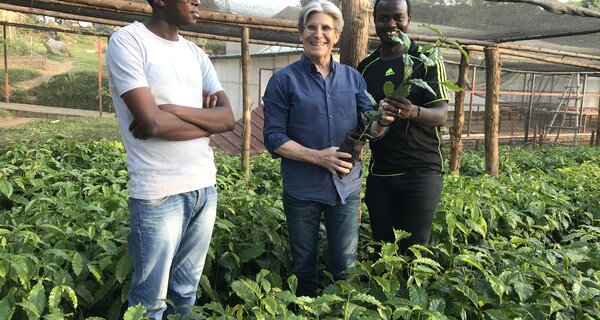A Closer Look at Coffee

19 November 2019
Coffee Expert Provides Update on Strategic Review of International Coffee Collection
For 70 years, the Tropical Agricultural Research and Higher Education Center (CATIE) in Costa Rica has been conserving coffee diversity. The International Coffee Collection it manages is made up of 12,000 trees representing 23 coffee species. Making sure this invaluable resource is safeguarded for the long term is no easy task. But an in-depth study organized by the Crop Trust and conducted by a coffee expert from Mauritius will outline how the many challenges can be better met.
“This study is the first concrete step in the implementation of the Global Conservation Strategy for Coffee Genetic Resources, a comprehensive overview of the world’s coffee diversity, its keepers and current status, that we facilitated together with World Coffee Research” said Marie Haga, former Executive Director at the Crop Trust. “It will help ensure the long-term conservation and availability of the world’s only coffee collection recognized under the Plant Treaty.”
“This diversity is the foundation that underpins the whole coffee industry. Traits found in these coffee plants will help develop new varieties that can thrive in uncertain climatic conditions. They can also provide us with new and exciting, and as yet unknown, coffee aromas and flavors.”
The Crop Trust and CATIE invited Dr Ehsan Dulloo to carry out the in-depth study. Ehsan has more than 30 years of experience working with coffee genetic resources. Based in Mauritius, his native country, Ehsan works for Bioversity International as Team Leader of its conservation program. His research activities focus on the in situ conservation of crop wild relatives. Under the CGIAR Research Program on Roots, Tubers and Bananas, he also leads the efforts to integrate conservation strategies for these crops.

Coffea liberica plant at the International Coffee Collection at CATIE.
Ehsan recently spent a week at CATIE working closely with Dominique Dessauw and William Solano, who are in charge of the coffee collection. He also met with various external users of the collection and members of CATIE’s management team. I reached out to Ehsan after he returned to Mauritius and asked him to share a bit about his background and provide an update on the study.
How did your involvement with coffee genetic resources begin?
Back in the 1980s, I became very interested in studying the native and endemic plants of Mauritius, more precisely, the wild relatives of our agricultural crops. Among these were three Coffea species that were known to be caffeine free. In 1988, I made a presentation on the conservation status of these wild coffees at the International Conference on Crop Genetic Resources Africa, which was held in Nairobi.
That presentation was the beginning of a long and productive career centered around the conservation and utilization of plant genetic resources, in which coffee featured prominently. Among Ehsan’s earliest contributions, he studied genetic diversity within and among populations of the wild coffee species of Mauritius and the effectiveness of protected areas in conserving this diversity. Ehsan also carried out a global assessment of coffee genetic resources in genebanks and developed a comprehensive conservation strategy for coffee genetic resources integrating genebanks and protected areas (Dulloo et al. 1998b).
I then pursued my research on coffee genetic resources at Bioversity International and facilitated the development of new conservation techniques for coffee. For example, I worked with the French organization Research Institute for Development (IRD) to develop a cryopreservation1 protocol for Coffea arabica. Back in the year 2000, this protocol was tested on CATIE’s coffee collection with very promising results.
In 2004, Andre Charrier, a renowned coffee expert, approached me to take the lead role in the development of a network of scientists working on the genomics of coffee.
How did you feel when the Crop Trust first approached you for this study?
I was extremely excited to have been offered the opportunity to undertake this detailed study on the status of this collection. The CATIE coffee field genebank is one of the most important and oldest coffee collections in the world. It contains the diversity collected in the historic collecting missions carried out by the Food and Agriculture Organization (FAO) and France’s Office of Scientific and Technical Research Overseas (ORSTOM, now IRD) in the 1960s and 1980s. These collecting efforts were prompted because, already back then, there was global concern that the genetic resources of coffee were disappearing.
For me, it is also interesting to study the effectiveness of a field genebank, as these have very particular challenges in conserving genetic diversity.
This work provides us with an opportunity to raise awareness about the uniqueness of CATIE’s collection. We need to further characterize and evaluate all of the materials held in the collection, so that we may truly understand what treasures are to be found there, and which trees can be used to solve the challenges of today and tomorrow in coffee breeding.

International coffee consultant, Dr Ehsan Dulloo, discussing coffee diversity with William Solano, head of CATIE's Technology Laboratory.
The study began in July 2019, when Mr Carlos Astorga, Ehsan’s local counterpart, was hired as an independent consultant to complete and update the inventory of the International Coffee Collection. That means going through each of the 12,000 trees in the collection, representing nearly 2,000 coffee varieties and two dozen wild species, and making sure all the relevant information about them is in a database. When Ehsan visited CATIE, he and Carlos discussed in detail the methodology that will be followed. By then, Carlos, a retired employee of CATIE who knows the collection well, had already started to collate information on the collection from various different sources, including CATIE’s current databases, historical information of the collection, and previous inventory data from 2008 and 2014.
Finishing the inventory of the collection is the first step in the study. How is it going?
Having a clear, complete picture of what is in the collection, and the state of these materials, is key for the whole evaluation. To date, nearly 70% of the collection has been inventoried. The work is ongoing. And though progress has been made, one of the limitations I saw during my visit was that there just weren’t enough field workers to carry out the inventory in a timely fashion. Fortunately, Dr Muhammad Ibrahim, CATIE’s Director General, has been very supportive; he committed to providing additional workmen to speed up the task. And now, thanks to this support, we expect the inventory to be finished by the end of December.
Ehsan’s visit to Costa Rica also provided him with the opportunity to meet with different national actors that use the genetic diversity managed by CATIE, including the technical staff at ICAFE (The Costa Rican Coffee Institute), the Costa Rica Specialty Coffee Association (SCA-CR), and various coffee producers, such as Cafetalera Origenes and GAIA Coffee.
Can you share some of the feedback you obtained from users of the collection?
Part of this study requires that we gain a better understanding of the needs of the industry, in terms of genetic resources. And the feedback from the coffee industry has been very positive; they recognize the value of the CATIE International Coffee Collection and are happy that this study is being done.
At ICAFE, I met with Dr Carlos Fonseca Castro, who is the Institute’s Technical Manager. According to him, breeding for drought is a high priority, in view of the impacts of climate change. They are working to develop varieties that can grow at lower altitudes in Costa Rica.
Mr Leonel Seo, from J&B Café International and Secretary of the Costa Rica Specialty Coffee Association, told me that the CATIE collection holds great promise for the discovery of traits for improved cup quality. He has already tested some samples from the core collection2 established by CATIE and World Coffee Research (WCR). Out of seven samples tested recently, three proved to be above the average quality of the coffee being grown in Costa Rica today. These plants, like many others, have been housed at CATIE for decades but have not yet been used in breeding.
Maybe the most important outcome of this initial trip was the opportunity for Ehsan, Carlos, and the CATIE team to fine-tune the criteria that will be used to decide, tree by tree, how to optimize management of the collection. One of these criteria is safety duplication. Copies of CATIE’s Core Collection can be found in El Salvador, Rwanda and in Starbuck’s Hacienda Alsacia in Costa Rica. But that’s just 5% of the whole collection. What about the rest?

Coffea arabica plant at the International Coffee Collection at CATIE.
Well, a while back, a backup of 63 samples was sent to the USDA [United States Department of Agriculture] genebank in Fort Collins, Colorado for conservation in a cryopreserved state. I’ve reached out to them to find out their current status.
But, yes, as you suggest, adequate safety duplication is an issue. It is important that the whole collection be maintained in a number of different places, because field collections are vulnerable to a whole range of adverse environmental and climatic factors, as well as to pest and diseases. The good news is CATIE is planning to duplicate part of the collection at a higher location, and relocate all of the collection to a better site. But it needs to be done in a comprehensive, well-planned manner.
So, what are the next steps?
There’s still a lot of work to be done, including finishing the inventory and carrying out the strategic prioritization of accessions. I must say that, among other things, this first trip was very useful in that it allowed us to review the working plan and take stock of what we have achieved to date. I plan to be back in CATIE early next year, to finalize the field work. Then, I’ll be ready to define strategic conservation actions.
This strategic study of the CATIE coffee collection is generously funded by FELCO, a family-owned Swiss pruning and cutting tools manufacturer that develops quality products known for their longevity. The findings of the study will provide a roadmap for CATIE to assure the collection is secure and made available to breeders and farmers and other users, for the next 70 years, and beyond.
Additional information:
The Crop Trust is an international organization working to support crop conservation in genebanks, forever. Through investment income generated by its endowment fund, it provides financial support to international, regional and national genebanks, and the world’s backup facility for genebanks, the Svalbard Global Seed Vault. The Crop Trust’s global patron is His Royal Highness, the Prince of Wales. www.croptrust.org
FELCO is the global leader in pruning shears and cable cutters for professional users. Located in Les Geneveys-sur-Coffrane, the Swiss company was founded in 1945 by Félix Flisch. Today, it employs over 200 staff who help turn out more than a million hand tools and 200,000 industrial tools every year, 90% of which are exported to over 100 countries. https://www.felco.com/
CATIE’s International Coffee Collection
Located in Turrialba, Costa Rica, far from coffee’s center of origin, this collection consists of almost 2,000 types of domesticated and wild coffee, maintained in close rows of trees on an 11-hectare farm. It has been assembled over the decades from Ethiopia, Yemen, Kenya, Tanzania, Colombia, Brazil, Mexico, and all over Central America. Its history goes back to the late 1940s. https://www.catie.ac.cr/en/
Notes
1 Cryopreservation is the process of preserving living systems by freezing them and storing them at ultra-low temperatures, usually in liquid nitrogen (-196°C) or its vapor phase (-150-195°C).
2 The Core Collection was created from CATIE’s large collection of more than 826 C. arabica plants, which WCR studied to determine the ones were the most genetically different from one another.
Category: Coffee



